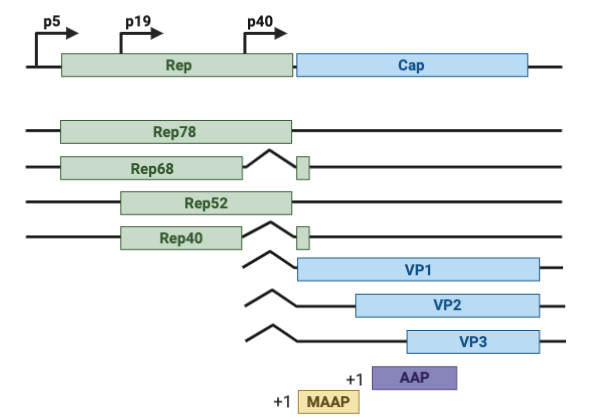Your next cool experiment requires some AAV. Where do you start? Plasmids of course! You just need three plasmids to start making the AAVs you need for your experiment:
- the packaging plasmid which contains the AAV structural and packaging genes,
- the adenoviral helper plasmid which contains the proteins needed for the virus to replicate,
- and the transfer plasmid which contains the viral genome.
In today’s blog post, we’ll focus on the packaging plasmid and take a look at each of its parts.
Key elements of the AAV packaging plasmid
The packaging plasmid aka the RepCap plasmid encodes two genes: the replication (rep) gene and the capsid (cap) gene. In wild-type AAV, these two genes are found between the AAV genome’s two inverted terminal repeats (ITRs); but when recombinant AAV (rAAV) is made in the lab, rep and cap are expressed from a separate plasmid in trans, freeing up space in the viral genome so that a gene of interest can be packaged into the virus instead.
Next let’s take a closer look at the rep and cap genes.
 |
| Figure 1. The RepCap plasmid and its products. Created with BioRender.com |
Replication (rep) gene
The rep gene encodes four proteins that are required for viral genome replication and packaging: Rep78, Rep68, Rep52, and Rep40. Rep gene expression is often driven by the AAV p5 or p19 promoters to, respectively, produce the large (Rep78 and Rep68) and small (Rep52 and Rep40) Rep proteins. Alternative splicing generates the different C-terminal regions of the Rep proteins. While the unique N-terminal domain of Rep78 and Rep68 contains a DNA-binding and endonuclease domains, all four Rep proteins share a common helicase and ATPase domains. To function, the Rep proteins form oligomers of Rep 78/68 or Rep52/40.
Rep78/68 play a key role in AAV genome replication. Replication initiates from the AAV genome ITRs on the transfer plasmid, which contain regions of dsDNA. To generate a 3’ hydroxyl group needed for DNA replication, Rep78/68 binds the Rep binding element (RBE) in the ITRs, uses its endonuclease activity to generates a ssDNA substrate which is then nicked by its endonuclease domain. Following replication, Rep78/68 stays attached to the AAV genome and docks with the genome onto an assembled capsid. Then Rep52/40, which also bind the capsid, “pumps” the genome into the capsid through a pore in the capsid. Rep proteins are also involved in the transcriptional regulation of the AAV p40 promoter which drives Cap expression.
Often Rep proteins from the AAV2 serotype are used to package vector genomes flanked by AAV2 ITRs into a capsid other than AAV2. This production strategy is called cross-packaging.
Capsid (cap) gene
The cap gene encodes three AAV viral capsid proteins VP1, VP2, and VP3, which together form the outer capsid shell that protects the viral genome. The cap gene is often driven by the AAV p40 promoter. Alternative splicing and differing translational start sites generate the three VP proteins. The three VP proteins assemble into capsid at a 1:1:10 ratio (VP1:VP2:VP3). There are eleven naturally occurring AAV serotypes that have thus far been identified: AAV1-11. Nine regions of variability in the cap gene which differ between the AAV serotypes are responsible for serotype-specific differences in tissue and/or cell type tropism. Introducing changes and/or short peptides sequences into these variable loops is one method for changing a capsid’s tropism.
cap also encodes the Assembly-Activating Protein (AAP) and the recently discovered Membrane Associated Accessory Protein (MAAP) from an alternative open reading frame (ORF). While AAP promotes virion assembly, the role of MAAP has not been clearly defined yet.
Now you’ve got a basic understanding of the AAV RepCap plasmid! Check out this blog post to learn more about the AAV transfer plasmid!
References:
- Naso MF, Tomkowicz B, Perry WL III, Strohl WR (2017) Adeno-Associated Virus (AAV) as a Vector for Gene Therapy. BioDrugs 31:317–334 . https://doi.org/10.1007/s40259-017-0234-5
- Büning H, Srivastava A (2019) Capsid Modifications for Targeting and Improving the Efficacy of AAV Vectors. Molecular Therapy - Methods & Clinical Development 12:248–265 . https://doi.org/10.1016/j.omtm.2019.01.008
- Maurer AC, Weitzman MD (2020) Adeno-Associated Virus Genome Interactions Important for Vector Production and Transduction. Human Gene Therapy 31:499–511 . https://doi.org/10.1089/hum.2020.069
Additional resources on the Addgene blog:
- Discover how the PHP.eB capsid was engineered
- Learn about the parts of the AAV transfer plasmid
Resources on Addgene.org
- Learn about AAV
- Find AAVs for your experiment
- Browse our AAV protocols
Topics: Viral Vectors, Viral Vectors 101, AAV






Leave a Comment